If ever there was a time for using Easter Eggs to jazz up instruction, it’s NOW. You are either waiting for spring break (and it can’t come soon enough) or you have had spring break and your kids still have spring fever. I hear ya! And let’s face it….you are having spring fever too–it’s not just the students! This is the time of year when everyone needs just a little bit more to get really engaged in instruction. It’s also the time of year when you feel like you couldn’t possibly create anything new. So what can you do?
Easter Eggs! Yes, those colorful plastic eggs that are all around in the Dollar Store and drug store and everywhere you go can be used to get your students engaged in your instruction. Those who have followed for a while know how much I love them…and I love them because they are so versatile! So to share my love of colorful plastic Easter eggs, I thought I would show you 21 ways you can use them (TOMORROW) in your classroom for more than just holding candy and having an egg hunt.
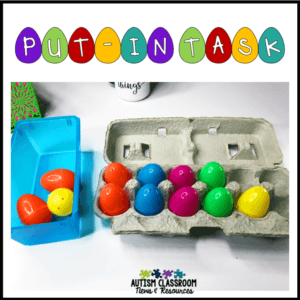 1. Put-In Task (with Egg Carton)
1. Put-In Task (with Egg Carton)
I love a good put-in task, as most of you know. For those unfamiliar, put-in tasks are the most basic of tasks that we often use in independent work systems. They involve simply putting an item into something. Easter eggs fit that bill quite well with an egg carton. All the students have to do is take them out of the bin and put them in the section of the carton. Done!
2. Matching Colors (with Egg Carton)
Have a student who can match colors, but maybe doesn’t have the fine motor skills to assemble the eggs? Color the bottom of the egg slots (are they slots…I don’t know what they are called). Then students put-in the color to match the color of the slot. You can also have them put one row of colored eggs. Students put the matching egg next to the same colored egg.
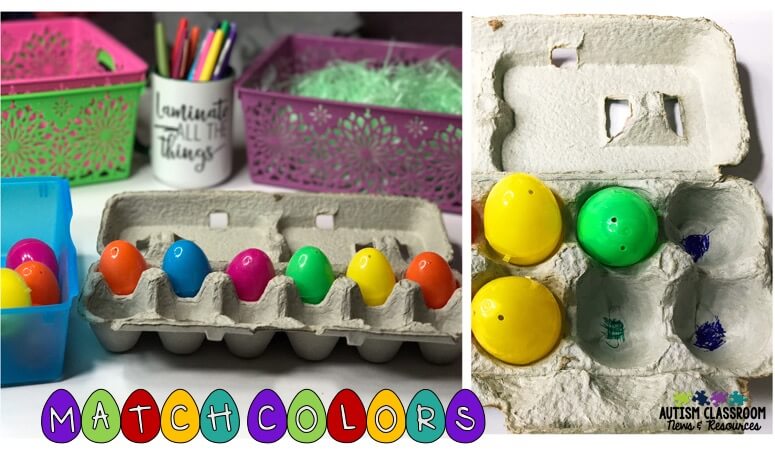
3. Assembly Matching Colors
Put each side of the eggs in a container and the students assemble them by matching the pieces and fitting them together.
4. Putting in Quantity
Take the eggs and write numbers on the outside with a permanent marker. Choose an item (e.g., mini erasers, coins) and have the students put the quantity in each egg and put them together.

5. Matching Money Amounts
Write an amount on the outside of the egg with a permanent marker. Or use dry erase tape (or just packing tape) and a dry erase marker, making it easy to change. Then students can put the matching amount of each egg. You can use a combination of coins or coins and bills.

6. Packaging Tasks
Take anything and have the students put items in inside the eggs and place them finished in a basket or bin. You can use pom poms, coins or erasers. You can have them use tongs or other tools to put the items in the eggs as well to make it more complex.

7. Count the Eggs
Simply have the students count the eggs. You can even use the egg carton to make a ten-frame by cutting the last 2 egg sections off…then you have ten egg spots (really I should figure out what to call those things).
8. Put Items in the Eggs and Have Students Count
Put little items in the eggs. Have the students open them, count the items (e.g., erasers) and record the number on an answer sheet.
9. Match Letters or Numbers
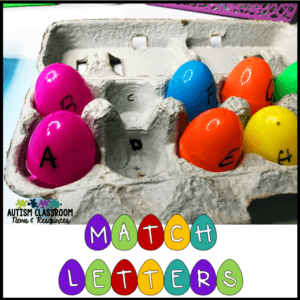
Put the number or letter on the egg and put it on the egg carton cell. Then students match the egg with A to the space with A. You can put a letter or number on the top and another on the bottom. Then have them match the halves and assemble them.
10. Math Facts
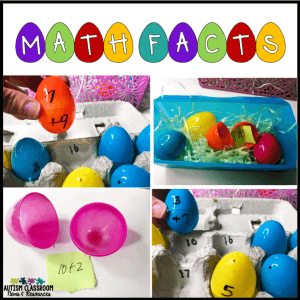
You can put the math problem on the top and the answers on the bottom. Then students assemble them. You can make them easier by having them match colors with the right problem or make it harder by having them assemble eggs with different color bottom and top. You can also put one part of the problem on the top, the other on the bottom. Then put the answer on the egg carton. Students put the egg together and put it in the carton to match the answer. You can also put cards/paper with the math problem inside the eggs and have the students answer them.
11. Sensory Bin (with Easter Grass)
A number of these ideas can be done putting the eggs in a bin with Easter grass. Then have them find it. You can have them find eggs by color (receptive ID of color), or use it with some if the suggestions above.
12. Labeling Colors
I love using eggs to have students label colors. If they label them right, they can find a reinforcer inside.
13. Requesting By Attribute
Eggs come in all different colors, of course. But they also come in all different sizes. You can use them to get students to learn to make requests requiring attributes (e.g., “I want the big egg,” “I want the blue egg”). Put the reinforcer in the one you want them to ask for. I put a piece of paper or something they don’t like or don’t like as much in the other as the natural consequence.
14. Keep Reinforcers Fresh

This is my favorite. I love to hide reinforcers in the eggs and have the kids earn them–and then get surprised by what’s in them. Put a chocolate or a small toy inside the egg and then they can be surprised each time.
15. Mystery Egg
If you have read my post about using Mystery Bag in instruction, the idea behind Mystery Egg is the same. Hide small items or pictures (like the one from file folders in the picture below). Have the students pick an egg, open it and describe what they find or label what they find.
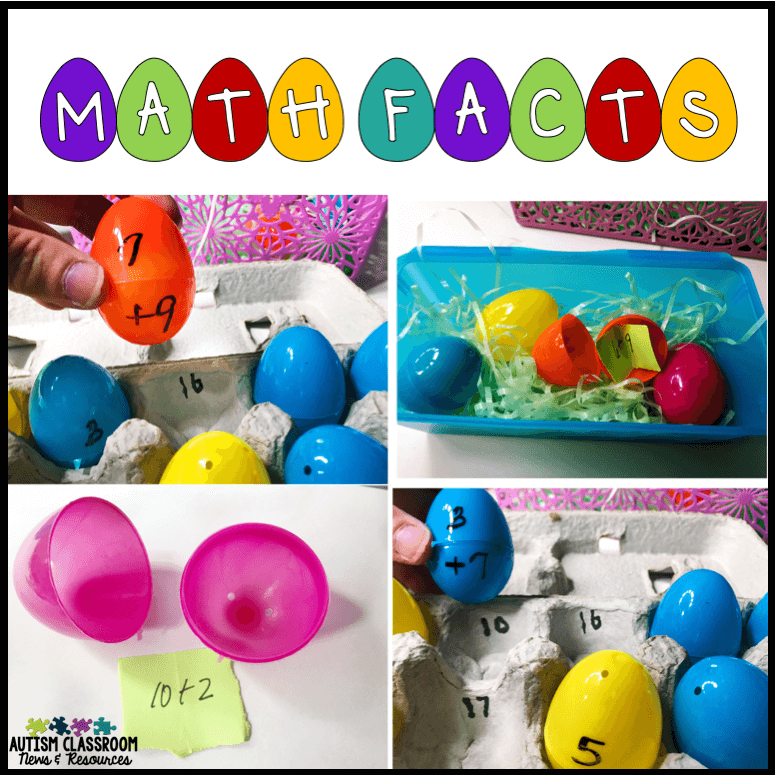
16. Read the Word
Put slips of paper with sight words or thematic vocabulary words in the eggs. Have students choose one, open it, and read the word.
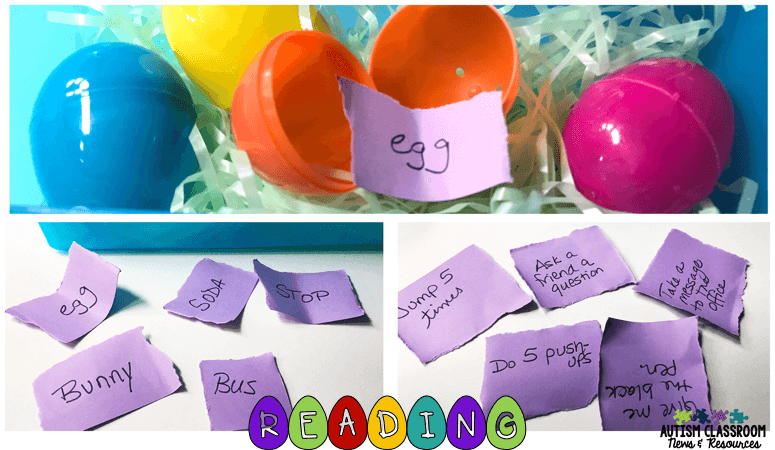
17. Read Directions / Sentences
I love to practice reading comprehension by putting short phrases or directions in the eggs. Students have to read them and follow the directions.
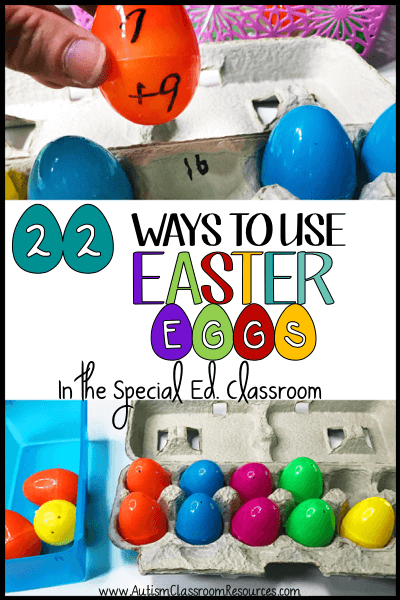
18. Treasure Hunt for Reinforcers
Hide the eggs with reinforcers in them so the students have to go hunt for them.
19. Scavenger Hunt
Put items the students have to find, or directions they need to find them. Then when they find them, they follow the directions to find things on their list.
20. Practice Positional Words Hiding Eggs
Give students directions using positional words (on the bookcase, under the chair) of where to place the eggs in the room.
21. Taking Turns
Have students take turns hiding and finding eggs.
22. Fill the Eggs and Deliver Treats
I love having an assembly line of the students filling the eggs with treats (confetti, jelly beans). Then having them deliver the eggs to teachers or other classrooms in the school. It’s a great way to work in social skills and work skills.
A quick shout out to Darcy Baldwin Fonts for the cute Easter Egg font in the pictures! So how do you like to use eggs in your classroom? I’d love to add to the list.




![Summer resources to help survive the end of the year in special education [picture-interactive books with summer themes]](https://autismclassroomresources.com/wp-content/uploads/2018/05/SUMMER-RESOURCES-ROUNDUP-FEATURE-8528-768x768.jpg)
